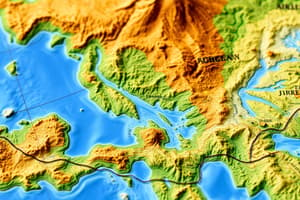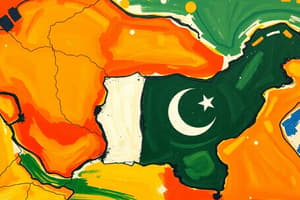Podcast
Questions and Answers
Which of the following is an advantage of vector data in GIS?
Which of the following is an advantage of vector data in GIS?
- Relatively large storage requirement
- Ability to handle multiple attributes for each object (correct)
- Can store continuous surface data
- Lack of topology
Raster data is capable of representing fuzzy objects.
Raster data is capable of representing fuzzy objects.
True (A)
Name two disadvantages of using raster data in GIS.
Name two disadvantages of using raster data in GIS.
Limited precision and its large file size
A key advantage of using a secant map projection over a tangential projection is that it _______ projection distortion.
A key advantage of using a secant map projection over a tangential projection is that it _______ projection distortion.
Match the following GIS methods to their appropriate characteristics:
Match the following GIS methods to their appropriate characteristics:
What does a local ellipsoid approximate in relation to the geoid?
What does a local ellipsoid approximate in relation to the geoid?
What is a spatiotemporal scenario in GIS?
What is a spatiotemporal scenario in GIS?
Vector data is incapable of representing continuous phenomena.
Vector data is incapable of representing continuous phenomena.
What is a primary advantage of network RTK over single-station RTK?
What is a primary advantage of network RTK over single-station RTK?
SWEPOS is a global network of positional reference stations.
SWEPOS is a global network of positional reference stations.
Explain the role of GPS satellites in single-station RTK.
Explain the role of GPS satellites in single-station RTK.
A _____ map uses polygons to represent data with constant attribute values.
A _____ map uses polygons to represent data with constant attribute values.
Match the following with their respective definitions:
Match the following with their respective definitions:
Which of the following is an example of a passive sensor?
Which of the following is an example of a passive sensor?
Active sensors, like radar, emit their own signals to collect data.
Active sensors, like radar, emit their own signals to collect data.
What is the significance of ionic activity in network RTK?
What is the significance of ionic activity in network RTK?
What is the primary purpose of secant projections in cartography?
What is the primary purpose of secant projections in cartography?
In a tangential projection, the paper touches the Earth along two meridians.
In a tangential projection, the paper touches the Earth along two meridians.
What geographic features does a typical 1:50,000 terrain map include?
What geographic features does a typical 1:50,000 terrain map include?
The referential skeleton of a terrain map in non-arid regions typically includes features like _____ and urban structures.
The referential skeleton of a terrain map in non-arid regions typically includes features like _____ and urban structures.
Match the following map types with their characteristics:
Match the following map types with their characteristics:
What happens to the scale in a secant projection compared to the tangent meridian?
What happens to the scale in a secant projection compared to the tangent meridian?
The central meridian in a secant projection coincides with the tangent meridian.
The central meridian in a secant projection coincides with the tangent meridian.
The average projection error is _____ in secant projections compared to tangential projections.
The average projection error is _____ in secant projections compared to tangential projections.
Flashcards
Secant Projection
Secant Projection
A map projection where the projection paper cuts through the Earth's surface, minimizing average scale error.
Tangential Projection
Tangential Projection
A map projection where the projection paper touches the Earth's surface along a meridian.
Central Meridian
Central Meridian
The line of longitude used as the reference point in a map projection.
1:50,000 Scale Map
1:50,000 Scale Map
Signup and view all the flashcards
Referential Skeleton (Map)
Referential Skeleton (Map)
Signup and view all the flashcards
Terrain Map Content
Terrain Map Content
Signup and view all the flashcards
Secant Cylinder Projection
Secant Cylinder Projection
Signup and view all the flashcards
Transversal Cylindrical Projection
Transversal Cylindrical Projection
Signup and view all the flashcards
Network RTK
Network RTK
Signup and view all the flashcards
Single-station RTK
Single-station RTK
Signup and view all the flashcards
SWEPOS
SWEPOS
Signup and view all the flashcards
Choropleth Map
Choropleth Map
Signup and view all the flashcards
Multivariate Representation
Multivariate Representation
Signup and view all the flashcards
Cartograms
Cartograms
Signup and view all the flashcards
Passive Sensor (Remote Sensing)
Passive Sensor (Remote Sensing)
Signup and view all the flashcards
Active Sensor (Remote Sensing)
Active Sensor (Remote Sensing)
Signup and view all the flashcards
Raster Data Advantages
Raster Data Advantages
Signup and view all the flashcards
Raster Data Disadvantages
Raster Data Disadvantages
Signup and view all the flashcards
Vector Data Advantages
Vector Data Advantages
Signup and view all the flashcards
Vector Data Disadvantages
Vector Data Disadvantages
Signup and view all the flashcards
Representing Spatiotemporal Change
Representing Spatiotemporal Change
Signup and view all the flashcards
Geoid and Local Ellipsoid
Geoid and Local Ellipsoid
Signup and view all the flashcards
Advantages of Secant Projection
Advantages of Secant Projection
Signup and view all the flashcards
Secant vs. Tangential Projections
Secant vs. Tangential Projections
Signup and view all the flashcards
Study Notes
Geographic Problems in GIS
- Geographic problems involve location, either in the information or the solution itself.
- Examples include forest management, precision farming, and navigation.
- Categorizing geographic problems is important due to their wide variety.
Methods for Categorizing Geographic Problems
- Scale: Defines the level of detail, including micro (e.g., crystalline structures), local (cities), regional (wide-spread epidemics), and global (pandemics).
- Intent/Purpose: Categorization based on goals. Examples include practical/urgent needs (emergency, money), and curiosity-driven investigations (continental plate movement).
- Time-Scale: Categorization based on the timeframe of the problem. Examples include operational tasks (everyday organizational functions), tactical planning (short-term plans), and strategic goals (long-term objectives).
Geographic Data (Datum)
- A datum contains a geographic position and its associated attribute value.
- A geodetic datum defines the position, and an attribute defines the associated descriptive property.
- Geographic attributes are classified in relation to their scale type.
Geographic Data Representation
- Raster: Information is regulated by pixel size.
- Vector: Information is regulated by the number of points an object is given.
Simplifying Geographic Reality
- Tessellation (Spatial Averaging): Simplifies reality by deciding pixel (density) size. More detail increases the number of pixels, while less detail decreases the number of pixels.
- Constant-Value: Simplifies large areas with similar attributes into a single value; e.g., the entire ocean could be given one value as the majority of an attribute is constant.
Studying That Suits You
Use AI to generate personalized quizzes and flashcards to suit your learning preferences.




